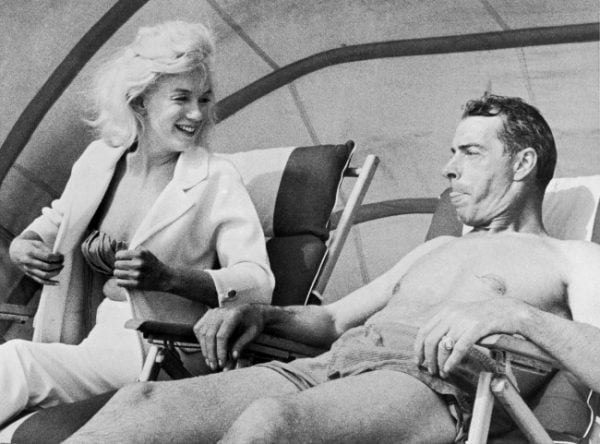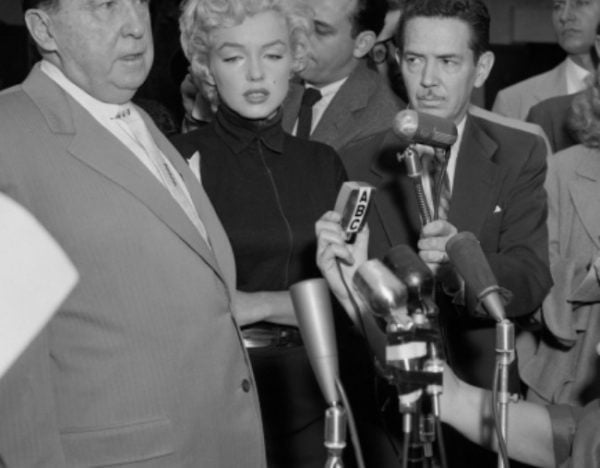- Richard C. Miller took this rarely-seen series of portraits of brunette starlet Norma Jean in 1946 when she was an up-and-coming Armed Forces pinup
- Miller was one of the first photographers to work with Norma Jeane Dougherty during this early period in her blossoming modelling career with the Blue Book Modeling Agency
- Among the many images that Miller made of her, one photograph depicts Norma Jeane wearing the wedding dress from her first marriage
- 'I had no idea when I was taking these pictures that she would become famous and that the pictures would become valuable,' Miller would later say. 'She was just a nice, sweet attractive girl with outrageous ambitions'
- The entire collection goes under the hammer at Santa Monica Auctions on Sunday, October 7 with an estimate of between $60,000 and $80,000
His pretty young muse dazzled in a lacy wedding dress, radiating innocence as she hugged a white prayer book close to her chest.
But while it would be years before Norma Jeane Dougherty blossomed into Hollywood siren Marilyn Monroe, storied photographer Richard C. Miller was in no doubt about the 19-year-old model's 'outrageous' ambitions.
Miller took a rarely-seen series of portraits of brunette starlet Norma Jean in 1946 when she was an up-and-coming Armed Forces pinup.
By the time they crossed paths more than a decade later on the set of Some Like it Hot she was a globally famous actress whose sex bomb looks transfixed generations.
Monroe called out 'Hi Dick' but the celebrated showbiz snapper was so shocked she remembered his name that he became tongue-tied.
'I had no idea when I was taking these pictures that she would become famous and that the pictures would become valuable,' Miller would later say. 'She was just a nice, sweet attractive girl with outrageous ambitions
Miller took a rarely-seen series of portraits of brunette starlet Norma Jean in 1946 when she was an up and coming Armed Forces pinup
Miller's prints will go under the hammer October 7 along with the original photographic model release form Norma Jean Dougherty signed on March 26, 1946
'He used Norma Jeane at four or five locations over several days,' the late photographer's daughter, Peg Miller, told DailyMail.com
Unsure whether to call her Marilyn, Norma Jean, or Nonny - the nickname Miller's daughters gave Monroe years earlier when she came to their home for dinner - he couldn't muster a single word.
'I had no idea when I was taking these pictures that she would become famous and that the pictures would become valuable,' Miller would later say. 'She was just a nice, sweet attractive girl with outrageous ambitions.'
Miller's prints will be up for auction on October 7 - along with the original photographic model release form Norma Jean Dougherty signed on March 26, 1946.
The rare collection, estimated to fetch up to $80,000, includes the white prayer book that actually belonged to Miller's wife, Margaret Dudley Miller.
'He used Norma Jeane at four or five locations over several days,' the late photographer's daughter, Peg Miller, told DailyMail.com. 'She evidently made enough of an impression that she came to dinner with us.
'I remember being told the story of how she was sat at the dinner table telling everyone that she wanted to become a star.
'Our parents thought, yeah right, sure - you and 20,000 other hopefuls. But sure enough, she made it happen.'
Norma Jeane was raised an orphan in Los Angeles, enduring an abusive, unhappy childhood before she married James 'Jim' Dougherty at 16 to escape a series of foster homes.
After dropping out of high school, the teenager turned bored housewife until Dougherty went to sea with the Merchant Marines and she took a job at a defence plant.
There, Norma Jeane caught the eye of propaganda photographers who visited the factory to take morale-boosting pictures of beautiful female workers.
She quit her job and in 1945 joined the Blue Book Model Agency who would book her for advertisements and magazines such U.S. Camera, Laff and Pageant, a rival to Reader's Digest.
Miller was one of the first photographers to work with Norma Jeane, his memorable image of her wearing her wedding dress and clutching his wife's prayer book appearing on the June 1947 cover of Personal Romances magazine.
Months later Norma Jeane signed for 20th Century Fox where executive Ben Lyon urged her to combine the name Marilyn with her grandmother's name, Monroe.
By then she had dyed her curly brunette hair platinum blonde and had divorced Dougherty because he was opposed to her acting career.
Success was fleeting however and it wasn't until a near-penniless Monroe posed for a set of nude photos in 1949 that her career truly took off, the ensuing notoriety helping her land a series of big roles when the raunchy pics surfaced several years later.
By 1953 Monroe had appeared in Gentlemen Prefer Blondes and How to Marry a Millionaire and was well on her way to becoming a household name.
By then she had dyed her curly brunette hair platinum blonde and had divorced Dougherty because he was opposed to her acting career.
Success was fleeting however and it wasn't until a near-penniless Monroe posed for a set of nude photos in 1949 that her career truly took off, the ensuing notoriety helping her land a series of big roles when the raunchy pics surfaced several years later.
By 1953 Monroe had appeared in Gentlemen Prefer Blondes and How to Marry a Millionaire and was well on her way to becoming a household name.
When she ran into father-of-three Miller, while shooting Some Like It Hot in 1959 she was at the peak of her fame - but also problematic on set.
Highly strung Hollywood types were nothing new to Miller, who had risen to become one of Tinseltown's most celebrated photographers, shooting the likes of Clark Gable, Shirley MacLaine, James Dean and Elizabeth Taylor.
'My father said Norma Jeane was an extremely good model when she started out. She had the charismatic quality that good models have,' added Peg, 73, a retired professor of English and higher education policy.
'But he didn't like her on the set of Some Like it Hot. By that time she was really challenged. She had trouble getting to the set on time. She had trouble getting her lines out.
'He remembered the moment Tony Curtis famously finished a kissing scene then stood up and said kissing Marilyn was just like kissing Hitler.
Monroe's troubled private life received almost as much attention as her bombshell looks as she struggled with substance abuse and depression.
Her second and third marriages to baseball star Joe DiMaggio and the playwright Arthur Miller both ended in divorce.
Monroe died from an overdose of barbiturates at her Los Angeles home on August 5, 1962. She was only 36.
Although the icon's death was ruled a probable suicide her demise has been subject to countless conspiracy theories.
Many of those who worked alongside her, including Miller, harboured doubts.
'Fame was too much for her, it really was,' added Peg. 'My father was very sceptical of the idea her death was suicide.
'There were all sorts of theories about who would have made it happen. He was more inclined to believe them.'
Miller died in 2010 at the age of 98.
His work is particularly sought after because he was a leading exponent of the carbro process, a painstaking, little-known printing technique that used liquid carbon and gelatin.
Each of Miller's prints could take as long as three days to process by hand - but the resulting images were known for their saturated, vibrant colours that didn't fade like regular prints.
The portfolio going to auction next week comprises 12 archival pigment prints capturing the youthful Monroe modelling by the pool, splashing around in the sea, fishing, carrying a cute puppy and playfully hopping a fence.
As well as the prayer book and the release form, there is a vintage, gelatin silver print of the starlet posing with Miller on a beach.
The entire collection goes under the hammer at Santa Monica Auctions on Sunday, October 7 with an estimate of between $60,000 and $80,000.


































